And then I became an adult and learned to appreciate the desert and how plants and animals adapt to live in such a harsh environment, to see its contrasts and beauty. We have a membership to the Garden and I now enjoy going as often as I can. (SIDE NOTE: I often see young children at the Garden complaining to their parents about how boooooorrrring it is and I smile to myself as I wonder how many will grow up to love the desert as I did. If my parents had not exposed me to it as a child, would I still love it as much as I do today? I think probably not. Kudos to the parents who "make" their children experience new things even though they are "bored!")
We recently went with friends (Doug & Anne and Richard) to take advantage of the gorgeous spring weather and the beauty of the desert interspersed with the fragile-looking Chihuly Exhibit.
We arrived at the Garden in the late afternoon on an overcast day. Although all of us had been to the Garden several times before, the focus of this visit was different. We wanted to see the Chihuly Exhibit both in daylight and at twilight.
The Sapphire Star (part of the Chihuly Exhibit) greeted us as we went through the admission gate. I have seen the Chihuly Exhibit five or six times during two different tours at the Garden and this one remains my favorite.
Dale Chihuly was first introduced to glass as an art form while studying interior design in the 1960's. After completing his degree, he studied glass in the U.S. and abroad learning from the best in the world before finding and developing his own style. His work is included in over 200 museum collections world-wide as well as numerous showcase pieces in hotel and office building lobbies.
The curving shape of the fragile glass contrasts with the straight sturdy cactus. I read that the workers who install the Chihuly exhibits in the garden wear protective clothing including kevlar shirts and gloves. I can certainly see why! It takes several days to put the entire exhibit together. Each "installation" is transported in pieces in boxes carefully marked so assembly goes smoothly.
There are 21 Chihuly "installations" (it's what they call them - but the word bothers me) on display in the Garden. They are of varying colors, shapes and sizes. Some are suspended above your head, others are on the ground. Some are interspersed in the cactus, others are not. And one is in water - well, technically, ON the water.
The brightly colored one on the top left is one that is suspended above you and is called "Polyvitro Chandelier and Tower." The one on the bottom right is in a row boat on the water. The "rock" in front of it is also glass - and looks like a giant blue ice cube. It reminded me of a chunk of ice that broke off an iceberg - perhaps contrasting the heat of the desert during the day with the cold nights. Or maybe I read too much into it?!?!
Gazing at these magnificent glass installations brings two questions to mind: how often do they break and how do they clean them. The simple answer to the first question is "less than 1% of the time." They are hand-inspected five times before they leave the studio and then are carefully hand-packed using custom-made packing materials and lots of bubble wrap and packing peanuts. Breakage usually occurs during installation or from weather-related incidents after installation. For those times, back-up pieces are sent with every exhibit. As for cleaning them, I assumed they hosed them off. What I learned was that they use microfiber towels to polish and clean them. That is one job I would NOT want! I know how filthy my glass-top table on our patio gets after a rain/dust storm - I can only imagine what these look like after a storm! But every time I have visited, they have been sparkling clean.
If the Chihuly Garden Exhibit is the frosting on the cake, then the sublime beauty of the desert is the delicious cake itself. The cactus, shrubs and wildflowers are interspersed with rock formations, desert washes (some with water!) and desert animals (we saw a jackrabbit, an owl, several lizards and some quail this trip). The views are different every time I go!
This Chihuly installation is the same red and yellow one in the collage above (top center). Silhouetted against the sky, it looks like it could be another saguaro- one with really long spines!
As the sun sets and the sky gets darker, the Chihuly installations look like they light up from the inside. In reality, spot lights on the ground aimed up at them provide their illumination. Most seem to glow! And all of them look different at night. They are even more fragile-looking and have an almost ethereal feel to them.
The one on the bottom left is called "Summer Sun" and is the largest of the 21 installations at the Garden.
Aristotle said, "Art takes nature as its model." The Chihuly in the Garden exhibit certainly illustrates that thought as the 21 installations convey through color, form and size the desert flora they imitate. Chihuly in the Garden will be around for a few more weeks - it's worth seeing if you can. (And I promise, no more DBG posts for awhile!)
The Sapphire Star at night makes me want to run up and touch it!

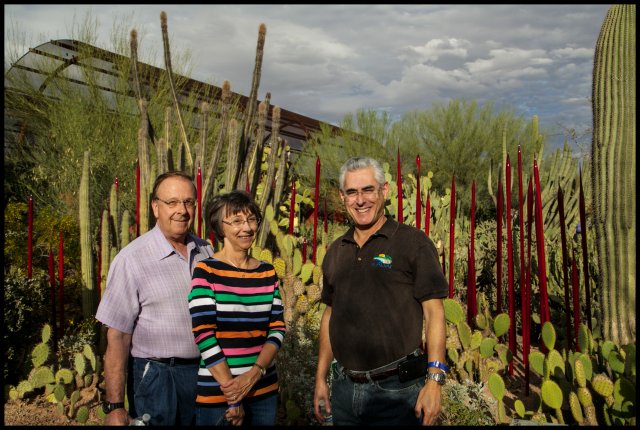

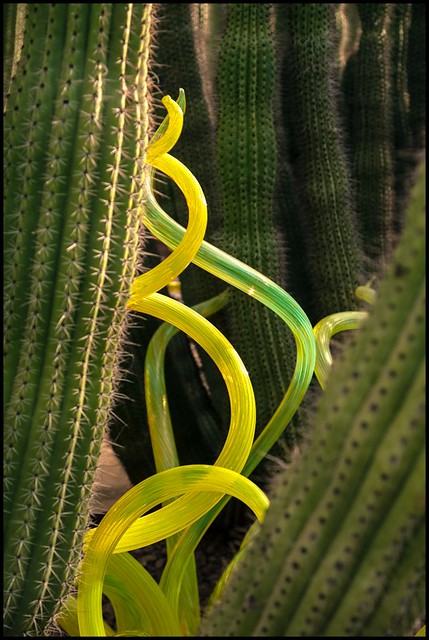
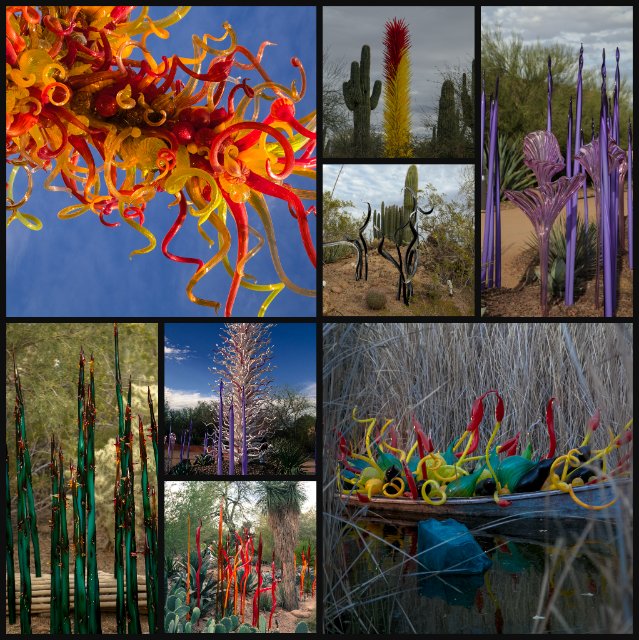

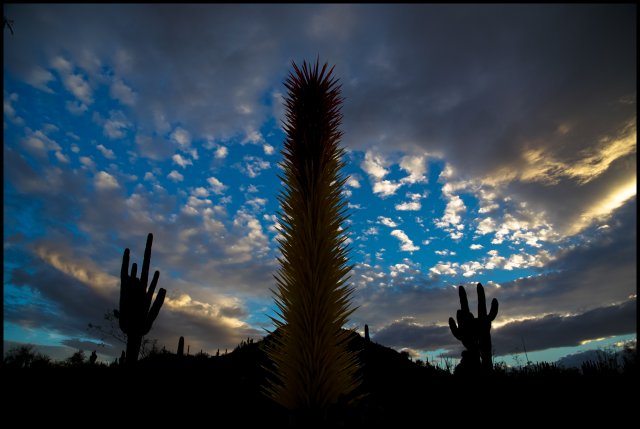
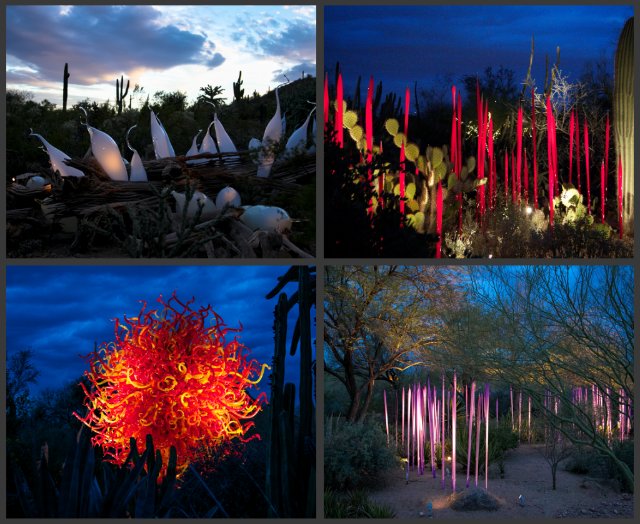
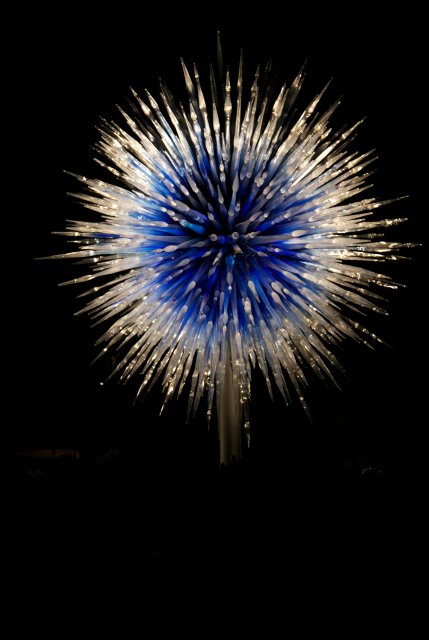
No comments:
Post a Comment